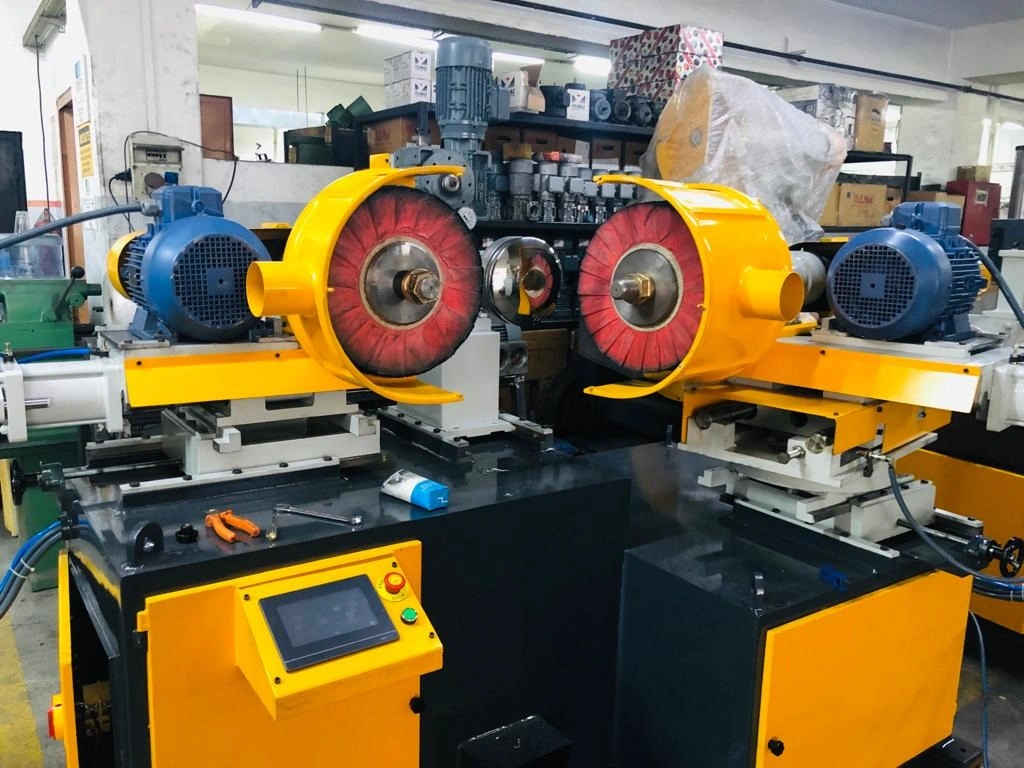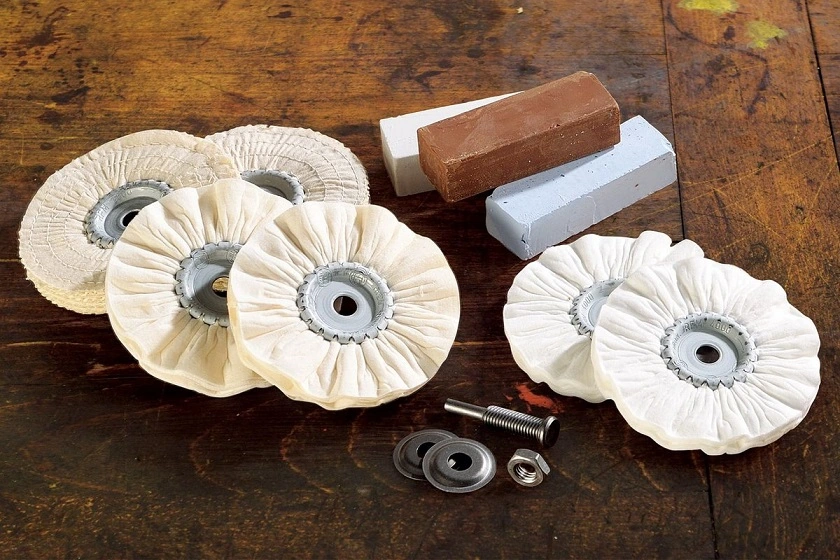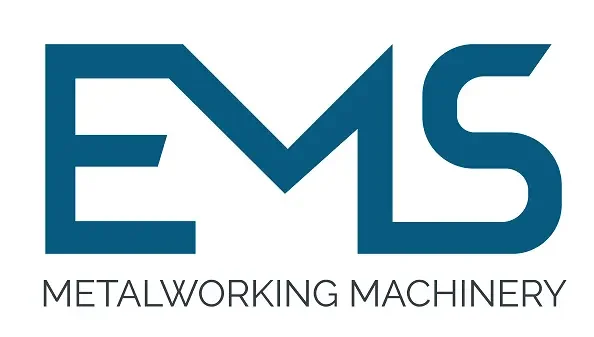
We manufacture Profiles and Sheets Finishing Machines from design to assembly. Polishing Buffing Machines for Cookware. Discount Price from the Manufacturer
Grinding is the most common form of abrasive machining. It is a material cutting process that engages an abrasive tool whose cutting elements are grains of abrasive material known as grit. These grits are characterized by sharp cutting points, high hot hardness, chemical stability, and wear resistance.
Abrasive-finishing tools can be divided into two states: bonded (fixed) and unbonded (loose) abrasive grains. In the bonded state, the abrasive grains are fixed within a matrix with an organic or vitrified bond. Bonded abrasive tools include abrasive stones (for honing and superfinishing), coated abrasives, and abrasive media for mass finishing. Abrasive stones consist of abrasive grains surrounded by bond material and containing a degree of porosity.
This is the same mixture used in grinding wheels. Abrasive stones are used in superfinishing and honing. Coated abrasives consist of a single layer of abrasive grains bonded by adhesives onto a flexible substrate such as paper, cloth, plastic films, or vulcanized fiber, converted into different shapes such as belts, discs, sheets, or brushes.
Profiles and Sheets Finishing Machines
Profiles and sheets finishing machines are crucial equipment in the metalworking industry, responsible for smoothing, polishing, and refining the surfaces of various metal extrusions, sheets, and plates. These machines play a pivotal role in enhancing the appearance, functionality, and overall quality of metal products.
Types of Profiles and Sheets Finishing Machines:
- Abrasive Belt Finishing Machines:
Abrasive belt finishing machines are widely used for smoothing and polishing flat surfaces of metal profiles and sheets. They utilize a series of abrasive belts that move continuously against the metal surface, removing imperfections, scratches, and blemishes. These machines are versatile and can handle a wide range of materials, including aluminum, steel, and stainless steel.
- Calendering Machines:
Calendering machines are employed for smoothing and leveling the surfaces of metal sheets, particularly in the production of high-quality precision sheets. They utilize a series of rollers that apply pressure to the sheet metal, eliminating surface imperfections and achieving a consistent thickness. Calendering machines are particularly suitable for thin sheets and can produce a mirror-like finish.
- Brushing Machines:
Brushing machines are used for cleaning, polishing, and deburring metal profiles and sheets. They utilize rotating brushes with various bristle types, ranging from soft nylon brushes for delicate surfaces to abrasive wire brushes for heavy-duty deburring. Brushing machines are effective for removing dirt, debris, and burrs, preparing the metal surface for further processing.
- Buffing Machines:
Buffing machines are employed for achieving a high-gloss finish on metal profiles and sheets. They utilize rotating buffing wheels and polishing compounds to remove fine scratches, imperfections, and haze, restoring the metal’s original shine. Buffing machines are commonly used for finishing decorative metal components, automotive parts, and architectural elements.
- Coating Machines:
Coating machines apply protective or decorative coatings to metal profiles and sheets. They utilize various coating methods, such as spraying, dipping, and electroplating, to apply layers of paint, lacquer, or other protective finishes. Coating machines enhance the corrosion resistance, durability, and aesthetics of metal products.
Key Features of Profiles and Sheets Finishing Machines:
- Adjustable Speed Control: Precise speed control allows for tailoring the finishing process to the specific type of metal, surface condition, and desired finish.
- Variable Abrasive Media Selection: The choice of abrasive belts, brushes, or polishing compounds depends on the material properties of the metal and the desired surface texture.
- Automated Control Systems: Advanced control systems ensure consistent finishing parameters, such as speed, pressure, and abrasive media flow, maintaining quality and minimizing variations.
- Safety Features: Safety features, such as guards, interlocks, and emergency stop buttons, protect operators from potential hazards during the finishing process.
Benefits of Using Profiles and Sheets Finishing Machines:
- Enhanced Surface Quality: Finishing machines remove imperfections, scratches, and burrs, resulting in a smoother, more uniform surface finish.
- Improved Functionality: Smoother surfaces can reduce friction, wear, and corrosion, enhancing the functionality and lifespan of metal components.
- Enhanced Aesthetics: Finishing machines restore the shine and appearance of metal products, improving their visual appeal and value.
- Protective Coatings: Coating machines apply protective finishes that shield metal surfaces from corrosion, wear, and environmental damage.
- Precision and Consistency: Automated finishing machines ensure consistent results, minimizing variations and maintaining high-quality standards.
In conclusion, profiles and sheets finishing machines are indispensable tools in the metalworking industry, providing a range of benefits that enhance the quality, functionality, and aesthetics of metal products. By employing these machines in various stages of the manufacturing process, metalworkers can produce high-quality components that meet the demands of diverse applications.
The coated abrasives for the profiles and sheets finishing machines
The performance of coated abrasives is greatly affected by the size of the abrasive grains. Coated abrasives are mainly used for tape finishing and brushing. Another type of abrasives to generate a final surface finish includes non-woven abrasives, which are manufactured using nylon fibers impregnated with abrasive grain, i.e. bonded with synthetic resins. Abrasive media consist of abrasives bonded to a polymer core.
These tools are available in a variety of shapes including spheres, cones, triangles, ellipses, and cylinders, and are used in mass-finishing processes. In the unbonded-abrasive state, the abrasive freely participate in finishing. The abrasive tools are divided into three groups: free abrasive, abrasive slurries, and abrasive flow media.
When using unbonded abrasives, the viscosity of the abrasive carrier increases from the order of gases (lowest), liquids (medium), and solids (highest). Free abrasives are used in blasting and jet-finishing media. Abrasive slurries (using diamond, alumina, and zirconia abrasives) are used in lapping, polishing, and buffing. The slurries are available in water-based, alcohol-based, and oil-based formulations.
Abrasive flow media are used in abrasive flow machining (AFM) and magnetic-abrasive finishing (MAF). While the abrasive grains are mixed with a polymer carrier in AFM (Figure 2), the abrasive grains are mixed with ferromagnetic particles (such as iron particles) in MAF
Superfinishing with the Profiles and Sheets Finishing Machines

Superfinishing uses an abrasive stone pressed against the external (OD) surface of the rotating cylindrical workpiece while oscillating axially, i.e. perpendicular to the workpiece rotation. Superfinishing is widely used in the bearing and automotive industries, after a grinding operation, to improve surface finish (e.g. to increase the bearing area) and roundness and to correct the geometry (size and form).
The process should be carried out at a “sweet spot” – a critical contact pressure for a specific stone/workpiece combination – in order to obtain an optimal material removal. Carefully set process kinematics are used to avoid workpiece lobing – i.e. the division of the workpiece’s cylindrical shape into lobes and the formation of out-of-roundness (Varghese and Malkin 1998). Honing is similar to superfinishing, but is intended to primarily finish internal (ID) surfaces, so the abrasive stones are pressed outwards against the cylindrical internal surface.
The process is used in a wide spectrum of applications including engine cylinder liners (bores), gear bores, bearings, and hydraulic cylinders. Honing uses low-speed kinematics – consisting of three components of motion: rotation (tangential velocity), the outward motion of stones, and an oscillating motion (reciprocating strokes with longitudinal velocity) – producing a smooth, crisscrossed (hatched) surface and improved bore geometry.
Honing
The honing process is also used for finishing of gears – producing specific gear profiles and flank surface modifications. In gear honing, the rotating honing ring (tool) and the gear flank (workpiece) roll off against each other at a certain inclination (axis-crossing) angle. This process is also characterized by low-speed kinematics, where the cutting speed during gear honing is much lower compared to gear grinding.
The honed gears have advantages over ground gears with regard to their noise and wear properties. Another beneficial effect is the generation of compressive residual stresses on the flank surface, leading to longer service life for honed gears.
Film/tape finishing and brushing use coated abrasives, where either the coated abrasive or the workpiece is rotated or reciprocated. The relative motion and applied pressure between the abrasive tool and workpiece surface induce material removal.
Here it is important to apply sufficient pressure. The required pressure depends on the grain size, and finer grains in “elastic” contact with the workpiece might be ineffective for material removal. The flexibility of the coated-abrasive substrate, on the other hand, enables free-form surface and edge finishing. Tape finishing often follows superfinishing with abrasive stones, where the two processes are integrated into a single machine.
Tape finishing is supplemental since it can further improve the surface finish while maintaining the form or profile of the workpiece, for example, in finishing the cam lobes or the crankshaft-bearing journals. Abrasive-media finishing (mass finishing) refers to the simultaneous processing of multiple components in a container (bowl), usually with abrasive media and a compound solution.
The Mass Finishing with Profiles and Sheets Finishing Machines
The container is given a cyclical motion that causes the material to be removed from the workpieces as abrasive media press and/or rub against workpiece surfaces. Mass finishing is used for burnishing, deburring, edge-rounding, brightening, and surface texturing. It can be further classified into five methods (processes): vibratory finishing, rotary-barrel finishing
(tumbling), centrifugal barrel finishing, centrifugal disc finishing, and spindle finishing.
In the blasting and jet-finishing methods, the abrasive is mixed with gas or liquids (slurries) and removes material by being directed at the workpiece as a jet; the jet pressure (which imparts kinetic energy to the particles) determines the magnitude to which abrasive grains impact the workpiece surface in order to remove material. A wide range of pressure can be
used to achieve a desired surface; ranging from matte to mirror-like surfaces.
In lapping and polishing, an abrasive slurry is introduced between the workpiece and the tool (e.g., lap or polisher), and the finishing pressure is applied to the workpiece. The combination of workpiece and tool motions makes the slurry flow. The abrasive interaction (rolling, sliding, etc.) with the workpiece determines the mechanism of material removal.
The finishing system also plays an important role in material removal, and the fluid – especially its chemical and physical properties – affect the material-removal mechanism. In general, lapping (producing matte surfaces) is followed by polishing (producing mirror-like surfaces).
In buffing, the abrasive slurry is applied to a buff, which rotates at high speeds and is pressed against the workpiece to finish the surface with an accumulation of abrasive scratches. In abrasive-flow machining (AFM), the abrasive media is forced to flow in a restricted area and abrade the workpiece surface.
Finishing Pressure
The finishing pressure depends on the fluid dynamics of the media. AFM is used for smoothing machined surfaces, removing recast layers, or inducing compressive residual stresses to internal surfaces. In magnetic-abrasive finishing (MAF), the finishing pressure is generated by a magnetic field. The process uses magnetic abrasives and the efficiency of material removal depends on the size of abrasive particles.
MAF is also used not only for deburring but also for chamfering and edge finishing. In both methods, the finished surfaces are accumulations of scratch marks, generating mirror-like surfaces. The flexibility of the media
enables finishing of free-form and re-entrant surfaces or internal workpiece passages, which also makes it an attractive technology for finishing of additive-manufactured components, which are nowadays gaining momentum.
Fundamentals of abrasive finishing elements used by Profiles and Sheets Finishing Machines
Abrasive-finishing processes are mechanical in nature, meaning that material is removed by abrasive grains in a mechanical action, typically to form chips or small particles. The material-removal mechanisms are largely determined by the type of workpiece material. Finishing of metallic materials is primarily accomplished by ductile cutting (chip formation),
whereas the finishing of brittle materials (e.g. glasses, ceramics) is often dominated by brittle fracture and crack propagation.
One of the fundamental parameters for characterizing finishing processes is the specific energy, u, which is defined as the energy expended per unit volume of material removal (Malkin and Guo 2008). Any model for material removal must be able to quantify the magnitude of the specific energy and its dependence on the process conditions.
In 1974 (Snoeys and Peters 1974) proposed the equivalent chip thickness parameter, heq, which gained widespread popularity since it only depends on the machine input parameters that can readily be changed. The equivalent chip thickness captures a theoretical “ribbon” of removed material during finishing but does not take into account the contract length.
Nevertheless, the process conditions (geometry and kinematics) in finishing can be simply quantified by heq. Equivalent chip thickness has been found to be particularly valuable for correlating finishing process parameters with specific energy (Figure 3) for a particular abrasive-finishing process.
Surface Finishing
Surface finishing is a process that requires a variety of tools, materials, and – most importantly – highly specialized skills. One of the most technically advanced types of surface finishing is mold making, where the surface of the mold has a direct impact on the surface of the product being molded. Proper finishing is essential.
While the art of finishing takes years of experience to perfect, there are some basic principles and techniques that provide a good start
Machining is technically the starting point of the surface finishing process, but grinding is where the real work begins. After the metal is machined, its surface condition is usually rough with ridges and cutter marks. Finishers must use a hand grinder, the basic tool for light metal removal, to get the surface smooth enough to eventually finish with hand stones and, ultimately, diamond polish.
Hand grinders can be used with a variety of grinding wheels and stones in a variety of shapes, sizes, and grits. Selection of grit is important because starting with too fine grit can waste stones and time. Choose a coarser grit for roughing, and use increasingly finer grits as the surface begins to attain its final shape and size.
Abrasive Wheel
After deciding which stone or wheel to use, mount it in the grinder while inserting the shank as deeply as possible to avoid whipping. Light “dressing,” shaping the stone to the contour of the finished surface with a dressing stone, is required each time a stone is mounted in a grinder. This ensures the concentricity of the abrasive surface.
Grinders have a tendency to follow the wavy contours of the rough surface, which makes it difficult to develop the smooth or flat surfaces required for subsequent stoning. Whenever possible, direct the grinding strokes at a 45 deg to 90 deg angle relative to the grooves developed in the machining process.
Be sure that your hands and forearms are braced to provide maximum control over the tool, as this will influence the smoothness of the surface and the amount of finishing that will be required later. Before starting the actual grinding operation, decide how the grinder will be supported and how to hold it to permit the wheel or stone to properly address the surface. If possible, move the surface to a position that enables steady grinder control and permits easy, firm strokes.
